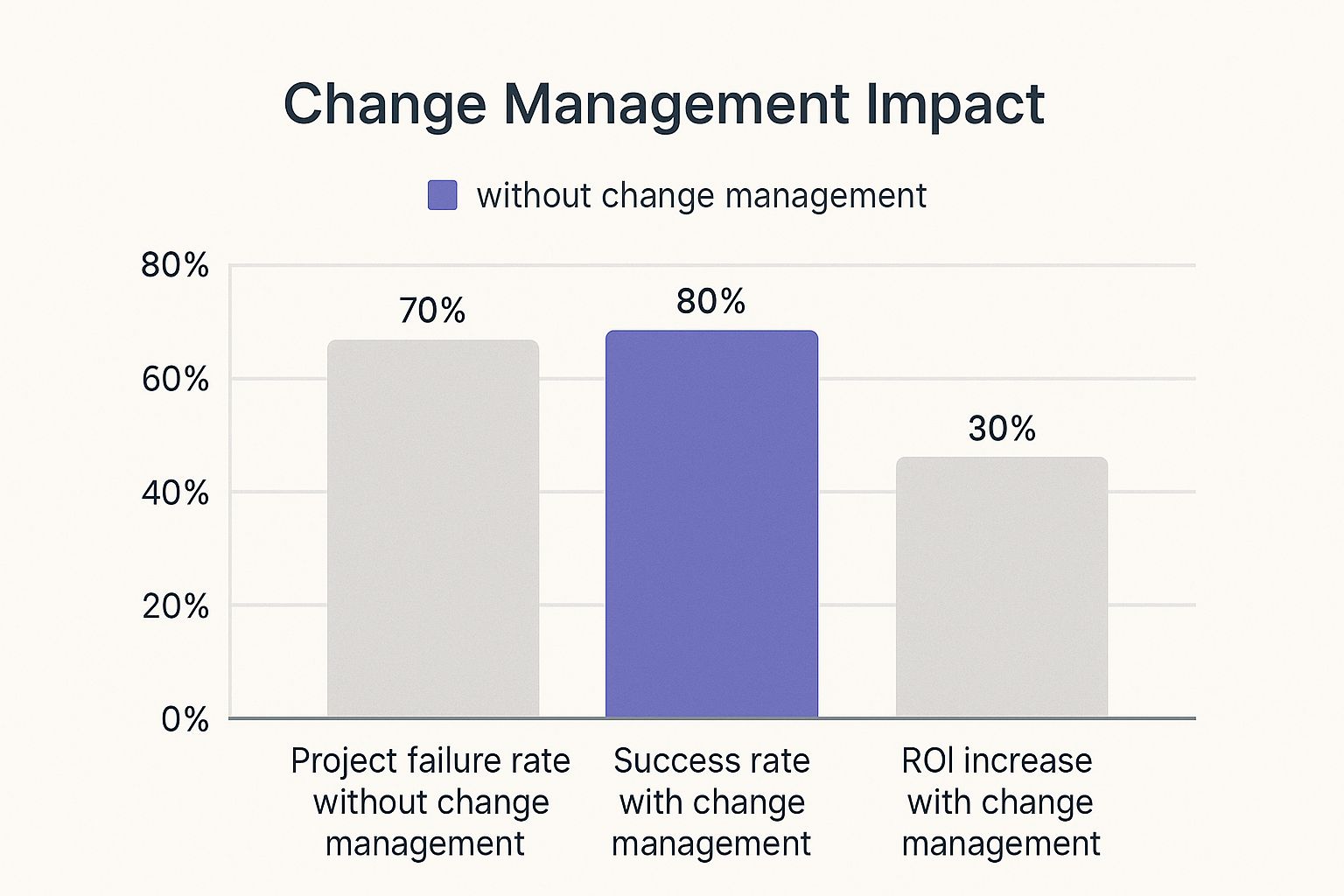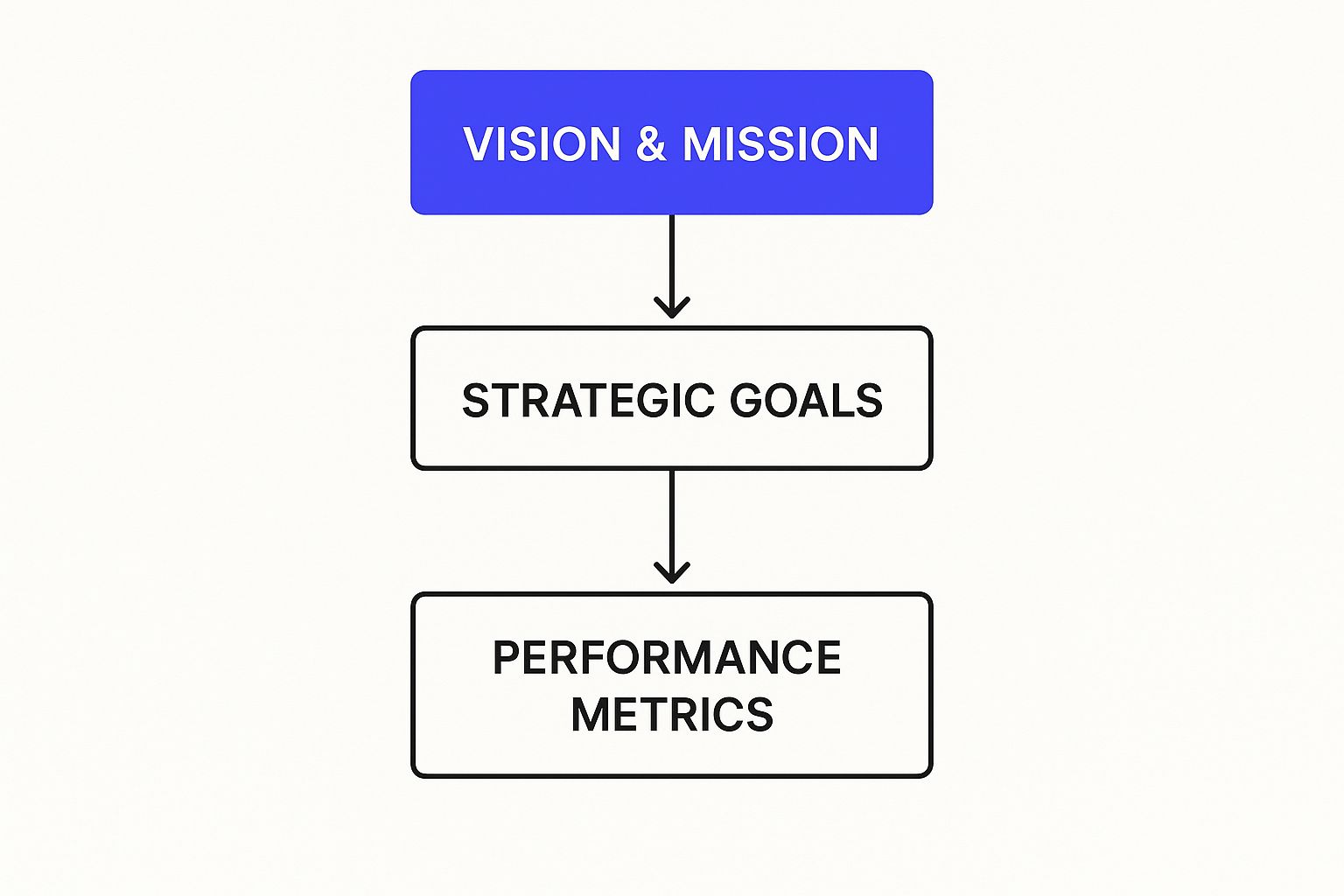Change is constant, but successful change is not. A solid change management implementation plan is the difference between a smooth transition that delivers value and a project that creates more headaches. It’s the structured, people-first way of preparing, supporting, and guiding everyone through the messy reality of adopting something new.
Why Change Management Implementation Often Fails
It’s a sobering thought, but most change initiatives simply don’t stick. We’ve all been there. A new system is launched with a big announcement, but a year later, everyone’s still clinging to their old, familiar workarounds. A new strategy is declared from the top, but day-to-day operations barely shift. This isn’t for a lack of good intentions. It’s because the most important piece of the puzzle is often an afterthought: the people.
Proper change management goes far beyond firing off a memo or scheduling a one-off training session. It gets to grips with the human side of change—the anxiety, the resistance, and the very real fatigue that kicks in when it feels like disruption is the new normal.
The data paints a pretty stark picture of what’s at stake.

As you can see, putting a proper change framework in place doesn't just nudge the odds in your favour. It fundamentally changes the game and dramatically improves project returns.
The real reasons for failure
When we dig into why these implementations so often falter, we find the same culprits time and again. These are not theoretical problems. They're the practical, on-the-ground blockers we see when we're called in to help organisations get unstuck. They’re often tangled together, creating a vicious cycle of resistance that can grind any project to a halt.
So, where do things typically go wrong?
- Poor communication. This isn’t about how many emails you send, but about the quality and clarity of the message. When the "why" behind the change is vague or unconvincing, people will fill in the blanks with their own stories, and those stories are rarely positive.
- Leadership disconnect. We often see a massive gap between the vision cooked up in the boardroom and the reality for teams on the front line. If leaders aren't visibly and actively championing the change, it sends a clear signal to everyone else that it’s not really a priority.
- Ignoring the human element. Change is deeply personal and emotional. It can trigger feelings of uncertainty, a loss of control, and a fear of not being able to keep up. Simply ignoring these completely valid emotions is a guaranteed recipe for failure.
The biggest mistake is focusing solely on the process or the technology while forgetting about the people. Success isn't about forcing a new tool on your team. It's about helping them understand why the change is necessary and genuinely showing them how it will make their work better.
The compounding effect of change fatigue
The sheer pace of modern business has created a state of almost constant flux, leading to widespread change fatigue. Recent UK data throws this challenge into sharp relief. A staggering 78% of employees reported experiencing more change during the pandemic than at any other point in their careers.
This relentless pressure has real consequences. When 37% of employees are actively resisting change and only 25% feel their senior leaders are any good at managing it, the path to failure is pretty much laid out. This environment helps explain why so many digital transformations fail to deliver, a topic we explore in much more detail elsewhere.
The table below outlines some of the most common barriers we see and how our integrated approach helps overcome them.
Common barriers to successful change implementation
By tackling these failure points head-on, you can reframe your approach. Instead of a top-down mandate that breeds resentment, you can foster a collaborative journey. This turns change management from a painful hurdle into a powerful opportunity to build resilience, free up your team’s time, and enable sharper, more sustainable decision-making for the future.
Building a People-First Change Blueprint

Let’s be honest. Real transformation isn't about a fancy new platform. It starts and ends with your people. A successful change management implementation relies on a blueprint built around the very individuals it impacts. This is why we champion a copilot approach, where we work right alongside your team, not dictate from an ivory tower.
This foundational work is all about empathy and listening. It means taking the time to understand the genuine fears, motivations, and potential roadblocks before they have a chance to derail your project. All too often, leaders charge ahead with a plan, only to be baffled by resistance that was entirely predictable and preventable.
When you put your people first, you build the trust and psychological safety needed to navigate any major organisational shift.
Conduct meaningful stakeholder analysis
Your first job is to figure out who is actually affected by the change. And no, this isn't just about creating a list of names and departments. A proper stakeholder analysis goes much deeper, uncovering the real dynamics of influence and impact across your organisation.
We find it helpful to think about it in these four groups:
- High Influence, High Impact. These are your most critical players. They might be senior leaders, but they could just as easily be long-serving team members whose opinions carry weight. You need them as your closest allies.
- High Influence, Low Impact. This group can easily shape opinions, even if the change doesn't really affect their day-to-day. Keeping them informed and on-side is vital to stop them from becoming vocal critics.
- Low Influence, High Impact. These are often the frontline staff whose jobs will change the most. While they might lack formal power, their collective buy-in is absolutely essential for the change to stick.
- Low Influence, Low Impact. This group needs clear, consistent communication, but they don't require the same intensive engagement as the others.
Once you’ve mapped this out, you can tailor your entire approach. This ensures the right people get the right information and the right level of involvement at the right time. This isn’t about manipulation. It's about respect and smart communication.
Identify your internal change champions
In every organisation, you'll find people who naturally get excited about new ideas and are trusted by their peers. These are your potential change champions, and frankly, they're the most valuable asset you have during any implementation. Crucially, they aren't always managers or senior leaders.
These champions become a vital bridge between the project team and everyone else. They can:
- Translate the high-level 'why' into practical terms that resonate with their colleagues.
- Give you honest, on-the-ground feedback about what’s really working and what isn’t.
- Bust myths and tackle concerns with an authentic, peer-to-peer voice.
A single, trusted champion advocating for a change within their team is often more powerful than a dozen emails from leadership. Their role is to build momentum from within, making the change feel like a shared endeavour rather than a top-down mandate.
Map communication channels that actually work
How does information really travel in your company? Hint. It’s rarely just through the official channels. Your blueprint has to acknowledge and use both the formal and informal communication networks.
Ask yourself these questions:
- Which team meetings are well-attended and taken seriously?
- Are there specific Slack channels or internal forums where the real conversations happen?
- Who are the unofficial "go-to" people that others turn to for the real story?
Crafting a solid change blueprint often means encouraging new ways of thinking and working. This is especially true when you're trying to improve how your organisation uses information. For leaders looking into this, it's often useful to learn more about building a data-driven culture, a common goal behind many of these big shifts.
By understanding these dynamics, you can make sure your key messages are delivered through the most effective channels, by the most trusted people. This kind of proactive planning is what turns your change blueprint from a static document into a living, people-focused guide for genuine, lasting transformation. It's how you build capability and ensure ownership stays with your team long after the project wraps up.
Aligning Leadership With Daily Operations
A change initiative without visible, active leadership is like a ship without a rudder. It might look impressive on paper, but it will just drift. The most common point of failure we see in change management implementation isn't a bad strategy. It's the canyon that opens up between a leader’s vision and a team's daily grind.
When change feels like something happening to people, not with them, it’s dead in the water. We have seen it countless times. A plan is announced with great fanfare, but on the ground, nothing feels different. Leaders continue to measure and reward the old ways of working, which sends a clear message that the change isn't a real priority. This breeds confusion and cynicism—the twin enemies of any real transformation.
Turning managers into change leaders
For any change to actually stick, it needs to be translated from lofty corporate goals into tangible actions that make sense to every single person in the organisation. This is where your managers are absolutely critical. They aren't just messengers. They are the interpreters, coaches, and on-the-ground champions who can close that leadership-to-operations gap.
But you can't just throw them in at the deep end. Managers need to be properly equipped, not just informed. This means giving them:
- A clear, compelling narrative. They must be able to confidently explain the "why" behind the change in a way that connects directly to their team’s specific challenges and goals.
- The authority to make decisions. When you empower managers to resolve minor roadblocks and adapt the plan for their team, you build ownership and agility from the middle out.
- Dedicated support. They need a safe space to ask questions, voice concerns, and get guidance without feeling like they’re failing.
Too often, managers get trapped in the middle. They’re expected to champion a change they had no role in creating and might not even fully understand themselves. Equipping them properly is the single most important thing you can do to align your organisation.
Translating strategy into everyday actions
So, how do you make a strategic goal like “improving operational coherence” feel real to someone in customer support or finance? You break it down. Forget abstract mission statements and focus on concrete, observable behaviours and tasks.
Let's say the big strategic push is to become more data-driven. Instead of just saying that, you could introduce:
- Weekly Team Huddles. Start each week by reviewing a key performance dashboard together. Talk about what the numbers mean and agree on one priority based on that data.
- Decision Logs. Create a simple, shared document where teams note key decisions and the data that informed them. It’s a small habit that builds huge transparency.
- Process Simplification. Challenge each team to identify one repetitive, low-value task every month that can be automated, freeing up time for more analytical thinking.
This approach makes the change tangible and far less intimidating. It shifts the focus from a massive, scary transformation to a series of small, manageable steps that build momentum over time.
The critical role of feedback and support
This alignment isn’t a one-way street from the top down. For this to work, you need a constant feedback loop. Leaders need to hear what’s working, what isn’t, and where the real-world friction points are. That requires creating channels for honest, psychologically safe feedback.
Unfortunately, many organisations fall drastically short here. Recent UK business insights reveal a worrying gap in management support. An alarming 71% of employees risk working on tasks that are completely irrelevant to organisational goals because leadership's plans fail to connect with day-to-day work. This is made worse by the fact that 59% of managers feel unsupported in handling their current challenges. You can dive deeper into these crucial findings in a 2025 study on UK change management statistics.
These figures aren't just numbers. They represent a critical breakdown. They show change efforts being systematically undermined by a lack of connection and relevance.
By actively closing this gap, you shift from a world where change is a top-down mandate to one where it’s a collaborative, evolving effort. When leaders are visibly engaged and responsive, and when strategic goals are clearly reflected in daily tasks, your people become part of the solution. This is how you build an organisation that isn’t just changing, but is genuinely becoming more capable.
An Actionable Toolkit for Executing Change

You’ve got your people-first blueprint and leadership is on board. Now comes the hard part: execution. This is where all that careful planning hits the messy reality of day-to-day work. Success here isn’t about sticking rigidly to a plan. It’s about being agile, learning as you go, and using small, visible wins to build momentum.
The whole game is about turning talk into action, moving from idea to implementation. You need practical tools that empower your teams, not overwhelm them with abstract goals. It’s about taking it one concrete step at a time.
Manage resistance by addressing it head-on
Resistance isn't your enemy. Honestly, it's some of the most valuable feedback you will get. When people push back, it's rarely because they want to cause trouble. More often, they have genuine worries about their workload, their job security, or whether this new system is actually going to work. Ignore them at your peril. It’s the quickest way to kill morale.
So instead of trying to silence the sceptics, bring them into the conversation. Create safe spaces where they can voice their concerns without any comeback. Acknowledge their points, and if you can, get them involved in finding the solution. We have seen it time and again. Your loudest critics can become your biggest champions once they feel heard and their insights are valued.
Run effective pilot programmes
Before you even think about a company-wide rollout, you need to test your ideas in a controlled setting. Think of a pilot programme as your organisational lab. It’s your chance to test, learn, and tweak everything on a small scale, ironing out all the kinks before they can cause chaos across the board.
When you're setting up a pilot, make sure you:
- Pick a representative group. Don’t just choose the most tech-savvy team. You need a mix of skills, comfort with digital tools, and workflow complexities that reflect the wider organisation.
- Set clear success metrics. What does a win actually look like? Is it less time spent on manual data entry? Faster reports? Or maybe just higher team morale? You need to know what you're measuring.
- Gather feedback relentlessly. Use daily stand-ups, weekly check-ins, and open forums to find out what’s working and, just as importantly, what’s not.
This approach de-risks the big launch and gives you hard evidence of the benefits. That evidence is pure gold when it comes to winning over everyone else.
The quality of change management has a direct and measurable link to project outcomes. In fact, research shows that projects with excellent change management are almost 8 times more likely to meet or exceed their objectives.
That statistic says it all. Good change management implementation isn't just a 'nice-to-have'. It's what makes or breaks a project. Yet so many UK change programmes falter, often because they think change management is just about sending a few emails and running a training session. It’s not. It requires strategic engagement at every level to get real buy-in and make sure the change aligns with what the business is actually trying to achieve.
Maintain transparency and track progress
Trust is everything, and it’s built on transparency. In the old-school consultancy world, progress reports are often a black box, with a glossy slide deck appearing at the end. We work differently because we believe in building collective intelligence and shared ownership.
Using a central hub, something like our Plans Portal, lets everyone see the progress against defined deliverables in real-time. This isn't about micromanaging. It's about having a single source of truth that keeps leadership aligned and teams in the loop. When people can see the small wins stacking up, it creates the momentum needed to push through the tough spots and ensures the change sticks for good.
Sustaining Change and Measuring True Impact
Getting a new system or process live isn't the finish line. It’s the starting block. The true test of any change management implementation is whether it actually sticks. We’ve all seen it. A big new initiative launches with a bang, only to fizzle out as old, familiar habits start creeping back in.
This final, and arguably most critical, phase is all about keeping that initial momentum going and, crucially, measuring the things that really matter.
This is where we have to look past the vanity metrics, like hitting a 'go-live' date. Instead, let's focus on the tangible business outcomes. Are we actually freeing up our team's time? Are our leaders making sharper decisions because the data is better? Is the business becoming more resilient and operationally sustainable?
The aim isn't just to introduce something new. It’s about creating a more open, more capable organisation where the new way of working becomes the norm simply because everyone can see it’s better. This is how you build genuine digital sovereignty—by ensuring the skills, ownership, and confidence stay right where they belong: inside your team.
Reinforcing new behaviours
For change to become permanent, it needs to be woven into the very fabric of daily work. This isn’t something that happens by accident. It requires a conscious, deliberate effort to reinforce the new behaviours you want to see. You're trying to create an environment where the new way is the easy way, the recognised way, and the rewarding way.
Here are a few strategies that work:
- Visible Recognition. Make a point of publicly celebrating the people and teams who get on board early. These are your champions. Highlighting their success shows everyone else what good looks like and gets them motivated.
- Ongoing Support. Don't fall into the trap of thinking one training session will cut it. It won’t. You need to provide continuous support, regular check-ins, and maybe even a few refresher sessions to build both confidence and competence over time.
- Embed in Performance. Link the new ways of working directly to performance management. When employee goals and reviews reflect the changes you want to see, it sends an unmistakable signal that this is a permanent shift, not just a passing phase.
The most effective organisational culture change strategies are those that make new behaviours feel natural and supported, not forced. It's about pulling people toward a better way of working, not pushing them away from the old one.
Measuring what really matters
To get a real sense of your change initiative's impact, you have to dig deeper than surface-level data. Real success is measured in the operational dividends it pays out. Are your teams genuinely spending less time bogged down in tedious, manual work? Are your leaders making faster, more informed decisions because they finally have the insights they need?
So, instead of asking, "Did we launch on time?" start asking better questions:
- How many hours per week have we actually reclaimed for higher-value work?
- Has our decision-making cycle for key business processes gotten any shorter?
- Are we seeing any measurable uptick in employee satisfaction or engagement scores?
This shift requires getting real, honest feedback. Just as product teams rely on effective feedback gathering techniques to refine what they build, you need that same level of candid input. Without it, you’re just guessing at the outcome.
Gathering feedback for continuous improvement
Change is never a one-and-done event. The period right after implementation is an absolute goldmine of learning that should directly inform your next cycle of improvements. You need to set up channels, both formal and informal, for your people to share what’s working, what’s not, and what could be even better.
This continuous feedback loop is absolutely vital. It does two things. It shows your team their experience and input are valued, and it helps you make those small, iterative tweaks that optimise the new process.
This is how you stop change from feeling like a top-down mandate and start turning it into a living, breathing part of your organisation’s DNA. And that is how you build a stronger, more adaptable business for the long haul.
Your Change Management Questions Answered

Even the most robust change management plan runs into real-world hurdles. Theory is one thing. But when you're in the thick of it, practical questions always bubble up. It's a complex field, and frankly, a good plan is just the starting line.
Here, we're cutting through the noise to answer the questions we hear most often from leaders. These aren't textbook answers. They're direct, candid, and grounded in our experience helping organisations like yours navigate the messy reality of genuine, sustainable change.
What is the biggest mistake to avoid in change management?
The single biggest mistake we see, time and again, is focusing entirely on the process or the technology while completely neglecting the people. Too many initiatives are framed around a new system to be installed or a shiny new workflow, with the human element treated as a box to be ticked later.
Successful change isn't about forcing a new tool on your team. It’s about helping them understand why the change is necessary in the first place, and more importantly, how it will make their work-life genuinely better.
Poor communication and a lack of empathy are the fastest ways to breed resistance and derail your entire project. If people feel like change is something being done to them, rather than with them, they will naturally push back.
How do you get buy-in from resistant team members?
It starts with one simple action: listening. Resistance isn't a character flaw. It's a valuable form of feedback. More often than not, it comes from a place of genuine concern—about increased workload, job security, or a legitimate fear that the new way simply won’t work as promised.
Engage your sceptics directly and honestly. Acknowledge their perspective, ask probing questions to get to the root of their worries, and wherever possible, involve them in finding a solution. We find our copilot approach, where we work alongside teams instead of dictating from above, is far more effective than any top-down mandate.
Often, your most vocal critics can become your greatest champions once they feel heard and see that their input is genuinely valued. We explore this in more detail in our guide to overcoming resistance to change in digital transformation.
How long should a change management implementation take?
There's no magic number. The right timeline depends entirely on the scale and complexity of the change, not to mention your organisation’s size, culture, and readiness for it. A simple process tweak in a team of 50 is worlds away from a full system overhaul in a company of 500.
Instead of getting fixated on a single, distant end date, we always recommend breaking the implementation into clearly defined deliverables and scoped stages.
This approach gives you several powerful advantages:
- Builds Momentum. Small, visible wins create a positive feedback loop and show everyone that real progress is happening.
- Increases Agility. It allows you to learn and adapt on the fly, responding to what's actually happening on the ground rather than sticking rigidly to an outdated plan.
- Ensures Transparency. We manage this through tools like our Plans Portal, which makes progress against deliverables visible to everyone. This transparency fosters a sense of shared ownership and accountability.
This method avoids the dreaded "big bang" implementation that so often ends in failure, replacing it with a more resilient and iterative journey.
What is the role of leadership during the change?
Leadership’s role is to be the active, visible, and unwavering champion of the change. This goes far beyond just signing off on the budget and kicking off the project. True leadership in change management requires presence, consistency, and commitment.
Leaders must constantly and clearly articulate the ‘why’ behind the initiative, connecting it directly to the organisation's core mission. Crucially, they must also model the desired new behaviours themselves. If you're asking your teams to adopt a new collaboration tool but leaders are still stuck in their email inbox, the entire initiative loses credibility. Fast.
Finally, leaders need to empower their managers. Give them the resources, training, and authority to properly support their teams through the transition. When leadership is disconnected from the daily realities of the change management implementation, momentum stalls, and the entire project is put at risk.










